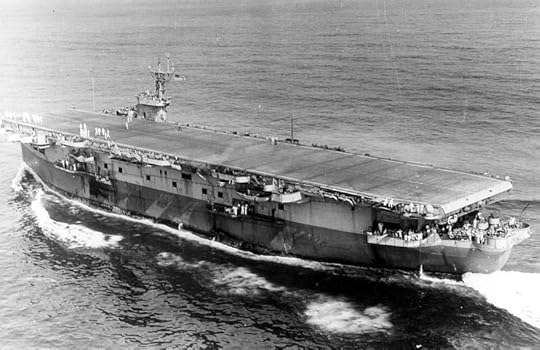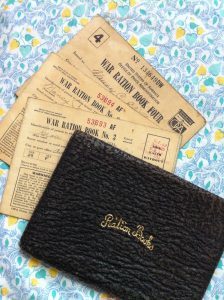Sarah Sundin's Blog, page 229
March 6, 2018
Today in World War II History—Mar. 6, 1943

US poster featuring Norman Rockwell’s “Freedom from Want,” 1943
75 Years Ago—Mar. 6, 1943: Germans release 1800 Jewish men detained at the Rosenstrasse in Berlin due to protests by their Gentile wives; they will survive the Holocaust.
Maj. Gen. George Patton replaces Maj. Gen. Lloyd Fredendall over US II Corps in Tunisia.
US Navy changes WAVES regulations to allow women to marry Navy men after training is complete.
Norman Rockwell’s “Freedom from Want” appears on the cover of the Saturday Evening Post.
March 5, 2018
Today in World War II History—Mar. 5, 1943

Auxiliary carrier USS Bogue (ACV-9) near Norfolk, VA, 20 June 1943 (US Navy photo)
75 Years Ago—Mar. 5, 1943: RAF sends 442 bombers to Essen, Germany, opening the Battle of the Ruhr—43 major raids through June.
Maiden flight of first British jet aircraft, the Gloster Meteor.
In convoy XK-2 off Cape Finisterre, German U-boat U-130 sinks four British freighters with one salvo of four torpedoes.
Auxiliary carrier USS Bogue begins escort of convoy HX-228 in North Atlantic, the first time this class of ship is assigned antisubmarine operations as primary duty.
March 4, 2018
Today in World War II History—Mar. 4, 1943

Waist gunners on a B-24 Liberator wearing protective flak vests and helmets (US National Archives)
75 Years Ago—Mar. 4, 1943: Academy Awards emceed by Bob Hope:
Best movie—Mrs. Miniver.
Best actor James Cagney in Yankee Doodle Dandy
Best actress Greer Garson in Mrs. Miniver
Best director William Wyler for Mrs. Miniver.
US 91st Bomb Group conducts first trial of armored flak vests.
March 3, 2018
Today in World War II History 75 Years Ago—Mar. 3, 1943

Japanese ship seen from a low-flying B-25 bomber of the US 3rd Bomb Group during the Battle of the Bismarck Sea, 2-4 Mar 1943 (public domain via WW2 Database)
75 Years Ago—Mar. 3, 1943: During Luftwaffe air raid on London, panic causes 173 deaths in Bethnal Green tube station.
In Battle of the Bismarck Sea, Allied aircraft sink Japanese destroyers Asashio, Arashio, Tokitsukaze, and Shirayuki.
March 2, 2018
Today in World War II History—Mar. 2, 1943

Bombing of a Japanese ship by a B-25 bomber of the US 3rd Bomb Group during the Battle of Bismarck Sea, 2-4 Mar 1943 (public domain via WW2 Database)
75 Years Ago—Mar. 2, 1943: In the Battle of the Bismarck Sea (March 2-5), US Fifth Air Force and Royal Australian Air Force aircraft sink all 8 transports in a Japanese convoy to Lae, New Guinea, and 4 of 8 escorting destroyers; US B-25 Mitchell medium bombers pioneer the use of skip-bombing.
Movie premiere of The Human Comedy, starring Mickey Rooney and Frank Morgan, also Robert Mitchum’s debut.
March 1, 2018
Today in World War II History—Mar. 1, 1943
 75 Years Ago—Mar. 1, 1943: Rosenstrasse Protests begin in Berlin—thousands of Gentile women married to Jewish men protest Nazi detention of their husbands, the only mass protest of the deportation of the Jews in Germany.
75 Years Ago—Mar. 1, 1943: Rosenstrasse Protests begin in Berlin—thousands of Gentile women married to Jewish men protest Nazi detention of their husbands, the only mass protest of the deportation of the Jews in Germany.
Atlantic Convoy Conference meets in Washington DC to decide British, Canadian, and US roles in trans-Atlantic shipping.
Gen. Carl Spaatz takes command of US Twelfth Air Force in Algeria.
War Ration Book Two issued in US: canned goods and other processed foods are now rationed at two pounds per week. (Read more: “Make It Do—Rationing of Canned Goods in World War II”)

Carl Spaatz, WWII (US Air Force photo)
February 28, 2018
Christian Fiction Scavenger Hunt Stop #11
 Welcome to the Christian Fiction Scavenger Hunt! If you’ve just discovered the hunt, be sure to start at Stop #1, and collect the clues through all 30 stops, in order, so you can enter to win one of our top 5 grand prizes!
Welcome to the Christian Fiction Scavenger Hunt! If you’ve just discovered the hunt, be sure to start at Stop #1, and collect the clues through all 30 stops, in order, so you can enter to win one of our top 5 grand prizes!
The hunt BEGINS on 3/1/2018 at noon MST with Stop #1 at LisaTawnBergren.com .
Hunt through our loop using Chrome or Firefox as your browser (not Explorer).
There is NO RUSH to complete the hunt—you have all weekend (until Sunday, 3/4/2018 at midnight MST)! So take your time, reading the unique posts along the way; our hope is that you discover new authors/new books.
Submit your entry for the grand prizes by collecting the CLUE on each author’s scavenger hunt post and submitting your answer in the Rafflecopter form at Stop #30. Many authors are offering additional prizes along the way!
 It is my honor to host the incredible Beth Vogt. Beth’s contemporary romances have won numerous awards, and she’s well loved in the Christian writing community for her generous spirit. Here’s a summary of Beth’s upcoming novel, Things I Never Told You (Tyndale House, May 2018): Payton Thatcher’s life — her hopes and dreams — died the night her twin sister was killed. Maybe revealing a decade-old secret will heal the rift between Payton and her family. Or will Payton discover that sometimes family isn’t worth fighting for?
It is my honor to host the incredible Beth Vogt. Beth’s contemporary romances have won numerous awards, and she’s well loved in the Christian writing community for her generous spirit. Here’s a summary of Beth’s upcoming novel, Things I Never Told You (Tyndale House, May 2018): Payton Thatcher’s life — her hopes and dreams — died the night her twin sister was killed. Maybe revealing a decade-old secret will heal the rift between Payton and her family. Or will Payton discover that sometimes family isn’t worth fighting for?
The Push-Pull Between Sisters, by Beth Vogt
“A sister is both your mirror – and your opposite.” Elizabeth Fishel (1950-), author
Sum up sister relationships in one word? Complicated.
There are sisters who send one another Hallmark cards on their birthdays – or for no reason at all – the rhyming words inside extolling about how they are each other’s truest, best friends. And then there are those sisters who push each other’s emotional buttons – and I’m not talking about sisters still in elementary or high school. These are adults who make their younger sisters cry or their older sisters fume. And they do it with an almost maniacal glee. There are sisters who text or talk to each other every day, go shopping, meet for coffee … and sisters who don’t speak at all.
Why?
It’s the odd dynamic of the pull-push between sisters.
Sometimes a sister functions as a mirror, reflecting who you are back to you. Her words and actions highlight the similarities between you. Think of those common family traits you share with your sister. Your hair color. The same eye color. Or it could be something that bonds you as sisters. A love of classic movies. The memories of family vacations. Playing board games together – although there’s a hidden danger of competition there. But for now, we’ll focus on how such experiences pulls you and your sister close.
 At other times, that same sister’s words or actions reveal the differences between you – your distinctive likes and dislikes, your personalities, your dreams and goals. Your sister is outgoing while you’re introverted. Your sister gathers academic accolades and you don’t. You become the star on the tennis court and she abandons her racket in the corner. And sometimes because you’re different from your sister, you are somehow less than her … or vice versa. And this pushes you apart.
At other times, that same sister’s words or actions reveal the differences between you – your distinctive likes and dislikes, your personalities, your dreams and goals. Your sister is outgoing while you’re introverted. Your sister gathers academic accolades and you don’t. You become the star on the tennis court and she abandons her racket in the corner. And sometimes because you’re different from your sister, you are somehow less than her … or vice versa. And this pushes you apart.
As a sister, I’ve experienced both the joy of the pull between sisters … and the heartache of the push between sisters. As a mom, I’ve watched my daughters navigate their relationships with one another, and do so with grace and laughter. Which is why I wrote these words at the beginning of my upcoming release that examines the dynamics between four sisters, Things I Never Told You:
“To my daughters, Katie Beth, Amy, and Christa; You define sisters beautifully. And for that, I am thankful.”
When it comes to sisters, there is no one-size-fits-all relationship. There needs to be room for both the pull and the push so that sisters can grow into individuals while maintaining their love and respect for one another.
 Beth K. Vogt believes God’s best often waits behind the doors marked “Never.” A Christy Award winner, as well as an ACFW Carol Award winner, Beth is the author of nine contemporary romance novels and novellas. Her first women’s fiction novel, Things I Never Told You, releases May 2018 from Tyndale House Publishers.
Beth K. Vogt believes God’s best often waits behind the doors marked “Never.” A Christy Award winner, as well as an ACFW Carol Award winner, Beth is the author of nine contemporary romance novels and novellas. Her first women’s fiction novel, Things I Never Told You, releases May 2018 from Tyndale House Publishers.
Here’s the Stop #11 Skinny: You can order Beth’s book on Amazon, Barnes & Noble, CBD or at your local bookstore!
Clue to Write Down: completed
Link to Stop #12, the Next Stop on the Loop: Beth Vogt’s own site!
Additional Giveaway!

But wait! Before you go, I’m offering a copy of my newest novel, The Sea Before Us plus a The Sea Before Us totebag! All you have to do is sign up to get my email newsletter (see “subscribe to my newsletter” button in my website header) or note that you’re already a subscriber, and enter the Rafflecopter below. (US addresses only please). Winner will be announced here on my blog March 5, 2018.
Today in World War II History—Feb. 28, 1943

Norsk Hydro plant in Rjukan, Norway, 1935 (public domain via Norwegian Museum of Cultural History)
75 Years Ago—Feb. 28, 1943: Norsk Hydro Raid: 10 Norwegian commandos blow up entire German supply of heavy water at Norsk Hydro plant at Rjukan, Norway, delaying German production of nuclear weapons.
Construction of Ledo Road construction crosses border from India into Burma, with goal of reconnecting with China.
Construction begins on first full-scale plutonium production reactor in the world at Hanford, WA.
February 27, 2018
Today in World War II History—Feb. 27, 1943

US poster, WWII, featuring Norman Rockwell’s “Freedom of Worship”
75 Years Ago—Feb. 27, 1943: New songs in Top Ten: “For Me and My Gal,” “That Old Black Magic.”
Norman Rockwell’s “Freedom of Worship” appears on the cover of the Saturday Evening Post.
February 26, 2018
Make It Do – Rationing of Canned Goods in World War II

Rationing of processed foods was an important part of life on the US Home Front. A complex and constantly changing system kept the grocery shopper on her toes.
Why processed foods?
Tin was short.
The Japanese controlled 70 percent of the world’s tin supply. Tin’s resistance to temperature, shock, and moisture made it an ideal packaging material. The US military used it for ration tins, ammunition boxes, plasma containers, and for morphine syrettes. The use of tin for civilian purposes had to be curtailed, which meant rationing of canned goods. (See Make It Do – Metal Shortages in World War II)
Food was in high demand.
In addition to meeting civilian needs, US farms also fed the military and the Allies. However, an agricultural labor shortage due to the draft and the internment of Japanese-Americans strained the system. Reducing civilian usage of processed fruit and vegetable products through rationing helped reduce the strain.
Which processed foods were rationed?

Starting March 1, 1943, three hundred items were rationed, including canned or bottled or frozen fruits and vegetables, canned or bottled juices and soups, and dried fruits. Fresh fruits and vegetables were not rationed, nor were pickles, relishes, or Jell-O.
Points
Each rationed item was assigned a point value, which varied over time due to supply, demand, and region. The job of the grocer became more complicated. Products had to be labeled not only with price but with point value. Each month, point values changed, and the grocer had to re-label.

US rationing books owned by my mother and grandmother, WWII (Photo: Sarah Sundin)
War Ration Book Two
On March 1, 1943, War Ration Book Two became active. The blue stamps provided 48 points worth of processed foods each month. This supplied 33 pounds of canned goods per person per year, which was 13 pounds less than prewar usage. Rationing calendars were published in the newspapers to help people keep track of which stamps were current. Stamps were good for eight, five, two, or one points each, with no “change” given, so the shopper had to be careful to use the exact number of points. To prevent fraud, the stamps had to be torn off in the presence of the grocer.
War Ration Books Three and Four
Book Three became active in September 1943, but was replaced by Book Four on November 1, 1943. The system was simplified on February 27, 1944, when all stamps became worth ten points, and plastic tokens were issued as change.
Fluctuations

Point values changed frequently, and items were often removed from or returned to rationing based on the harvest. On September 17, 1944 after a good harvest—and in preparation for the presidential election—all processed foods except canned fruit were removed from rationing, but were returned to rationing on January 1, 1945 due to the demands of the Battle of the Bulge. After V-J Day on August 15, 1945, processed foods were no longer rationed.
 Victory Gardens
Victory GardensPeople were encouraged to plant Victory Gardens to reduce the amount of processed foods needed. Newspapers and magazines published how-to articles, and gardens sprang up in backyards, vacant lots, big-city window-boxes, and even on community property. By the end of 1943, Victory Gardens supplied 40 percent of civilian needs for fruits and vegetables.
Canning

To put up this bounty, home canning was encouraged. A poll in January 1944 found that 75 percent of housewives canned, and those women canned an average of 165 jars per year. This met the family’s needs and preserved ration points for foods they couldn’t grow. Extra canned fruits and vegetables were often donated to the needy.
How would you like to deal with a system like this?



